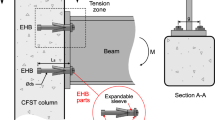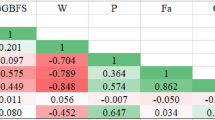Abstract
This paper presents a new machine learning-based calibration framework for strength simulation models of self-piercing riveted (SPR) joints. Strength simulations were conducted through the integrated modeling of SPR joints from process to performance, while physical quasi-static tensile tests were performed on combinations of DP600 high-strength steel and 5754 aluminum alloy sheets under lap-shear loading conditions. A sensitivity study of the critical simulation parameters (e.g., friction coefficient and scaling factor) was conducted using the controlled variables method and Sobol sensitivity analysis for feature selection. Subsequently, machine-learning-based surrogate models were used to train and accurately represent the map** between the detailed joint profile and its load-displacement curve. Calibration of the simulation model is defined as a dual-objective optimization task to minimize errors in key load displacement features between simulations and experiments. A multi-objective genetic algorithm (MOGA) was chosen for optimization. The three combinations of SPR joints illustrated the effectiveness of the proposed framework, and good agreement was achieved between the calibrated models and experiments.





















Similar content being viewed by others
Abbreviations
- frt:
-
Friction coefficient between the rivet and the top sheet
- frb:
-
Friction coefficient between the rivet and the bottom sheet
- fss:
-
Friction coefficient between the top and bottom sheets
- rivsfo:
-
Scaling factor for the material curve of the rivet
- maxf:
-
Peak load of the load-displacement curve
- stiff:
-
Stiffness of the load-displacement curve
- maxdis:
-
Displacement at peak load of the load-displacement curve
- failuredis:
-
Failure displacement of the load-displacement curve
- \({\text{maxf}}_{{\text{s}}}\) :
-
Peak load in simulation
- \({\text{maxf}}_{{\text{E}}}\) :
-
Peak load in the experiment
- \(K_{{\text{s}}}\) :
-
Stiffness in simulation
- \(K_{{\text{E}}}\) :
-
Stiffness in experiment
- \(E_{{{\text{maxf}}}}\) :
-
Peak load error between simulation and experiment
- \(E_{{{\text{stiff}}}}\) :
-
Stiffness error between simulation and experiment
- \({\text{maxdis}}_{{\text{s}}}\) :
-
Displacement at peak load in simulation
- \({\text{maxdis}}_{{\text{E}}}\) :
-
Displacement at peak load in experiment
- \({\text{failuredis}}_{{\text{s}}}\) :
-
Failure displacement in simulation
- \({\text{failuredis}}_{{\text{E}}}\) :
-
Failure displacement in the experiment
- \(E_{{{\text{maxdis}}}}\) :
-
Error of displacement at peak load between simulation and experiment
- \(E_{{{\text{failuredis}}}}\) :
-
Failure displacement error between simulation and experiment
References
Zhang W, Xu J (2022) Advanced lightweight materials for automobiles: a review. Mater Design 221:110994. https://doi.org/10.1016/j.matdes.2022.110994
Li D, Chrysanthou A, Patel I et al (2017) Self-piercing riveting‒a review. Int J Adv Manuf Tech 92:1777–1824
Li M, Liu Z, Huang L et al (2022) Automatic identification framework of the geometric parameters on self-piercing riveting cross-section using deep learning. J Manuf Process 83:427–437
Li M, Liu Z, Huang L et al (2023) Multi-fidelity data-driven optimization design framework for self-piercing riveting process parameters. J Manuf Process 99:812–824
Sui B, Du D, Chang B et al (2007) Simulation and analysis of self-piercing riveting process in aluminum sheets. Mater Sci Tech-Lond 5:713–717
Wan S, Hu S, Li SY et al (2007) Process parameters and joint evaluation of self-piercing riveting with half-hollow rivets. J Tian** Univ 4:494–498
Liu XQ (2007) Experimental investigation and finite element numerical simulation of self-piercing riveted process. Dissertation, Tian** University
Bouchard PO, Laurent T, Tollier L (2008) Numerical modeling of self-pierce riveting—from riveting process modeling down to structural analysis. J Mater Process Tech 202(1/3):290–300
Casalino G, Rotondo A, Ludovico A (2008) On the numerical modelling of the multiphysics self piercing riveting process based on the finite element technique. Adv Eng Softw 39(9):787–795
Kang SW, Huang ZC, Chen XM (2008) Introduction of fretting in self-piercing riveting. Coal Mine Machinery 6:7–9
Grujicic M, Snipes J, Ramaswami S et al (2014) Process modeling, joint-property characterization and construction of joint connectors for mechanical fastening by self-piercing riveting. Multidiscip Model Materials and Structures 10(4):631–658
Hanssen A, Olovsson L, Porcaro R et al (2010) A large-scale finite element point-connector model for self-piercing rivet connections. Eur J Mech A-Solid 29(4):484–495
Chung CS, Kim HK (2016) Fatigue strength of self-piercing riveted joints in lap-shear specimens of aluminium and steel sheets. Fatigue Fract Eng M 39(9):1105–1114
Yan W, **e Z, Yu C et al (2017) Experimental investigation and design method for the shear strength of self-piercing rivet connections in thin-walled steel structures. J Constr Steel Res 133:231–240
Bock FE, Blaga LA, Klusemann B (2020) Mechanical performance prediction for friction riveting joints of dissimilar materials via machine learning. Proc Manuf 47:615–622
Zhao H, Han L, Liu Y et al (2021) Quality prediction and rivet/die selection for SPR joints with artificial neural network and genetic algorithm. J Manuf Process 66:574–594
Jäckel M, Coppieters S, Hofmann M et al (2017) Mechanical joining of materials with limited ductility: analysis of process-induced defects. AIP Conf Proc 1896:110009. https://doi.org/10.1063/1.5008136
Kang H, Lee JH, Choe Y et al (2021) Prediction of lap shear strength and impact peel strength of epoxy adhesive by machine learning approach. Nanomaterials 11(4):872. https://doi.org/10.3390/nano11040872
Qi BF (2020) Crashworthiness analysis of heterogeneous metal automobile front rail. Dissertation, Dalian University of Technology.
**e Y (2019) Research on the performance of self-piercing riveting and its application on front longero simulation. Dissertation, Hefei University of Technology
Xu JS (2018) Simulation study on failure of self-piercing riveted joints between steel and aluminum. Dissertation, Jilin University
Zhang ZY, Shi BJ, Zhong JB (2019) Optimisation of parameter matching of semi-hollow self-pierce riveted joints in aluminium alloy car bodies. Mach Design Manuf Eng 48(3):64–68
Fang Y, Huang L, Zhan Z et al (2022) A framework for calibration of self-piercing riveting process simulation model. J Manuf Process 76:223–235
Haque R (2018) Quality of self-piercing riveting (SPR) joints from cross-sectional perspective: a review. Arch Civ Mech Eng 18(1):83–93
Ma Y, Lou M, Li Y et al (2018) Effect of rivet and die on self-piercing rivetability of AA6061-T6 and mild steel CR4 of different gauges. J Mater Process Tech 251:282–294
Huang L, Lasecki JV, Guo H et al (2014) Finite element modeling of dissimilar metal self-piercing riveting process. SAE Int J Mater Manu 7(3):698–705
Huang L, Wu Y, Huff G et al (2020) Sensitivity study of self-piercing rivet insertion process using smoothed particle Galerkin method. In: The 16th international LS-DYNA conference, 10–11 June, pp 1–11
Yue Z, Chen Q, Huang L et al (2023) A surrogate model based calibration method for structural adhesive joint progressive failure simulations. J Adhesion 99(10):1579–1606
Bhadeshia H (2009) Neural networks and information in materials science. Stat Anal Data Min 1(5):296–305
Li M, Liu Z, Huang L et al (2022) A new multi-fidelity surrogate modelling method for engineering design based on neural network and transfer learning. Eng Computation 39(6):2209–2230
Efron B, Stein C (1981) The Jackknife estimate of variance. Ann Stat 9(3):586–596
Soboĺ I (1993) Sensitivity estimates for nonlinear mathematical models. Math Model Comput Exp 1:407
Wan H, Ren W, Wang N (2015) Parameter selection and sampling methods for global sensitivity analysis of Gaussian process models. J Vib Eng 28(5):714–720
McKay MD, Beckman RJ, Conover WJ (2000) A comparison of three methods for selecting values of input variables in the analysis of output from a computer code. Technometrics 42(1):55–61
Gunantara N (2018) A review of multi-objective optimization: methods and its applications. Cogent Eng 5(1):1502242. https://doi.org/10.1080/23311916.2018.1502242
Marler RT, Arora JS (2004) Survey of multi-objective optimization methods for engineering. Struct Multidiscip O 26:369–395
Gao Y, Shi L, Yao P (2000) Study on multi-objective genetic algorithm. In: Proceedings of the 3rd world congress on intelligent control and automation, IEEE, 28 June–2 July, Hefei
Huang L, Guo H, Shi Y et al (2017) Fatigue behavior and modeling of self-piercing riveted joints in aluminum alloy 6111. Int J Fatigue 100:274–284
Jiang P, Zhou Q, Shao X et al (2020) Surrogate-model-based design and optimization. Springer, Singapore
Acknowledgments
This research was supported by the National Natural Science Foundation of China (Grant No. 52205377), the National Key Research and Development Program (Grant No. 2022YFB4601804), and the Key Basic Research Project of Suzhou (Grant Nos. SJC2022031, SJC2022029).
Author information
Authors and Affiliations
Corresponding authors
Rights and permissions
Springer Nature or its licensor (e.g. a society or other partner) holds exclusive rights to this article under a publishing agreement with the author(s) or other rightsholder(s); author self-archiving of the accepted manuscript version of this article is solely governed by the terms of such publishing agreement and applicable law.
About this article
Cite this article
Ji, YX., Huang, L., Chen, QR. et al. A machine learning-based calibration method for strength simulation of self-piercing riveted joints. Adv. Manuf. (2024). https://doi.org/10.1007/s40436-024-00502-3
Received:
Revised:
Accepted:
Published:
DOI: https://doi.org/10.1007/s40436-024-00502-3




